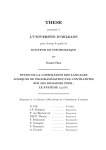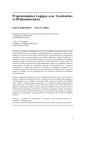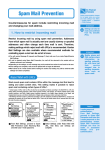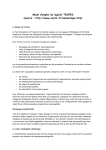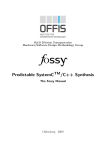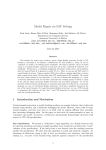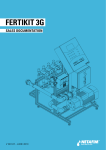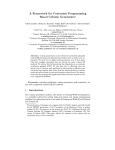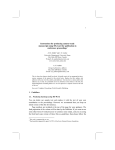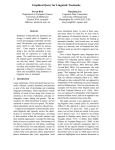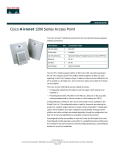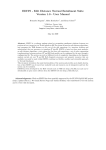Download PDF
Transcript
Boolean Constraint Solving Using clp(FD)
Philippe Codognet and Daniel Diaz
INRIA-Rocquencourt
Domaine de Voluceau BP 105
78153 Le Chesnay Cedex
FRANCE
{Philippe.Codognet, Daniel.Diaz}@inria.fr
Abstract
We present a boolean constraint logic language clp(B/FD) built upon a language
over finite domains clp(FD) which uses a local propagation constraint solver. It
is based on a single primitive constraint which allows the boolean solver to be
encoded at a low-level. The boolean solver obtained in this way is both very simple
and very efficient: on average it is eight times faster than the CHIP propagationbased boolean solver, i.e. nearly an order of magnitude faster, and infinitely better
than the CHIP boolean unification solver. It also performs on average several times
faster than special-purpose stand-alone boolean solvers.
1
Introduction
Constraint Logic Programming combines both the declarativity of Logic Programming and the ability to reason and compute with partial information (constraints)
on specific domains, thus opening up a wide range of applications. Among the usual
domains found in CLP, the most widely investigated are certainly finite domains,
real/rationals with arithmetic constraints, and booleans. This is exemplified by
the three main CLP languages: CHIP [22], which proposes finite domains, rational and booleans, PrologIII [5] which includes rationals, booleans and lists, and
CLP(R) [10] which handles constraints over reals. Whereas most researchers agree
on the basic algorithms used in the constraint solvers for reals/rationals (simplex
and gaussian elimination) and finite domains (local propagation and consistency
techniques), there are many different approaches proposed for boolean constraint
solving. Some of these solvers provide pecial-purpose boolean solvers while others
have been integrated inside a CLP framework. However, different algorithms have
different performances, and it is hard to know if for some particular application
any specific solver will be able to solve it in practise. Obviously, the well-known
NP-completeness of the satisfiability of boolean formulas shows that we are tackling
a difficult problem here.
Over recent years, local propagation methods, developed in the CHIP language for
finite domain constraints [22], have gained a great success for many applications,
including real-life industrial problems. They stem from consistency techniques introduced in AI for Constraint Satisfaction Problems (CSP) [11]. Such a scheme has
also been used in CHIP to solve boolean constraints with some success, to such an
extent that it has become the standard tool in the commercial version of CHIP.
This method performs better than the original boolean unification algorithm for
nearly all problems and is competitive with special-purpose boolean solvers. Thus,
the basic idea is that an efficient boolean solver can be derived from a finite domain
constraint solver for free.
1
It was therefore quite natural to investigate such a possiblity with our CLP system
clp(FD), which handles finite domain constraints similar to that of CHIP, but being
nevertheless more than twice as fast on average [6]. clp(FD) is based on the so-called
“glass-box” approach proposed by [23], as opposed to the “black-box” approach of
the CHIP solver for instance. The basic idea is to have a single constraint X in r,
where r is a range (e.g. t1 ..t2 ). More complex constraints such as linear equations
and inequations are then defined in terms of this primitive constraint. The X in r
constraint can be seen as embedding the core propagation mechanism for constraint
solving over finite domains, and can be seen as an abstract machine for propagationbased constraint solving.
We can therefore directly encode a boolean solver at a low-level with this basic
mechanism, and decompose boolean constraints such as and, or, and not in X in
r expressions. In this way, we obtain a boolean solver which is obviously more
efficient than the encoding of booleans with arithmetic constraints or with the less
adequate primitives of CHIP. Worth noticing is that this boolean extension, called
clp(B/FD), is very simple; the overall solver (coding of boolean constraints in X in
r expression) being about ten lines long, the glass-box is very clear indeed... Moreover, this solver is surprisingly very efficient, being eight times faster on average than
the CHIP solver, which was however reckoned to be efficient, with peak speedup
reaching twelve. clp(B/FD) is also more efficient than special purpose solvers. It
is interesting to remark that, on traditional finite domain benchmarks, clp(FD) is
twice as fast as CHIP, while on boolean examples clp(B/FD) is eight times faster.
This can be explained by two main reasons. Firstly, booleans are, to the best of our
knowledge, encoded at a finer granularity in clp(B/FD) than in CHIP, thanks to
the X in r decomposition. Secondly, clp(FD) integrates some global optimizations
on the handling of X in r, which benefit all non-basic constraints built upon it,
including in this case boolean constraints. This is not the case in CHIP where,
while the finite domains part (especially the treatment of linear constraints) certainly contains numerous ad hoc optimizations, the boolean part does not benefit
from them. Remark in passing that this is one more argument for the glass-box
approach versus the black-box approach. This architecture also has several other
advantages, as follows. First, being integrated in a full CLP language, heuristics
can be added in the program itself, as opposed to a closed boolean solver with (a
finite set of) built-in heuristics. Second, being integrated in a finite domains solver,
various extensions such as pseudo-booleans [2] or multi-valued logics [24] can be
integrated straightforwardly. Third, being based on a propagation method, searching for a single solution can be done much more quickly if the computation of all
solutions is not needed.
The rest of this paper is organized as follows. Section 2 introduces boolean constraints and the variety of methods proposed as boolean solvers. Section 3 then
briefly presents the clp(FD) system and the X in r primitive constraint. Sections
4 and 5 detail the propagation-based solver. A rule-based semantics is first introduced, and its equivalence to the usual declarative semantics of boolean formulas
is shown (section 4). The solver is then introduced and proved correct (section
5). Performances of clp(B/FD) are detailed in Section 6, comparing both with
CHIP and several other efficient dedicated boolean solvers. A short conclusion and
research perspectives end the paper.
2
2
Boolean constraints
We first present the basic notions of boolean expressions, and then review the
different approaches currently used to solve such constraints in existing systems.
Definition
A boolean formula on a set V of variables is defined inductively as follows:
• the constants 0 and 1 are boolean formulas,
• X is a boolean formula, for X ∈ V,
• X ∧ Y , X ∨ Y , ¬X , X ≡ Y are boolean formulas, for X and Y formulas.
The declarative semantics of the boolean connectives (∧, ∨, ¬, ≡) are given by the
well-known truth-tables.
Although the problem of satisfiability of a set of boolean formulas is quite old,
designing efficient methods is still an active area of research, and there has been
a variety of methods proposed over recent years toward this aim. Moreover, it is
usually important not only to test for satisfiability but also to actually compute the
models (assigments of variables), if any. To do so, several types of methods have
been developed, based on very different data-structures and algorithms. We have
chosen to classify existing methods, focusing on implemented systems, by considering as principal criterion the main data-structure used to represent constraints,
since it is of primary importance for performances.
Existing boolean solvers can thus be roughly classified as follows:
Resolution-based methods. Clausal representation and SL-resolution can obviously be used for boolean formulas, and such a method is indeed implemented
in the current version of Prolog-III [5]. However, the performances of this solver
are very poor and limit its use to small problems. An improved resolution-based
algorithm using a relaxation procedure is described in [8].
BDD-based methods. Binary Decision Diagrams (BDD) have recently gained
great a success as an efficient way to encode boolean functions [3], and it was natural
to try to use them in boolean solvers. BDDs are usually encoded as directed acyclic
graphs, where common subexpressions are merged. The boolean unification [12]
solver of CHIP uses such a BDD representation [4] [21]. Other solvers using BDDs
include the Adia solver [16], its improved version (second method of [18]) and the
Wamcc-Adia combination [7]. Such solvers are efficient for some circuit verification
applications, but do not have as good results for less symmetrical problems, e.g.
traditional boolean benchmarks, for the size of the BDD during the computation
can become very large. It is also very costly to maintain a normal form (the BDD)
and to recompute it each time a new constraint is added. Moreover, these solvers
are not apt to selectively compute, if desired, a single solution instead of all possible
ones.
Enumerative methods. These methods roughly consist in trying possible assignments by incrementally instanciating variables to 0 or 1 and checking consistency in various sophisticated ways. The seminal algorithm by Davis and Putman
3
falls into this category, although it can also be reformulated in the previous resolution framework. The basic idea is to build (implicitly or explicitly) a decision
tree by instanciating variables and backtracking. Boolean constraints are checked
for consistency as soon as all their variables become ground. [15] contains various
improvements in consistency checking, and [17] shows how to compute most general unifiers representating all possible models. New methods use a matrix-based
clausal form to represent constraints for efficiency reasons, either by bit-vector encoding [13] or with a spare-matrix representation (first method of [18]). They also
allow fixed variables to be detected quickly. These solvers can be made quite efficient
by introducing various heuristics.
Propagation-based methods. These schemes are based on local propagation
techniques developed for finite domain constraints and integrated in CLP languages
such as CHIP. They are very close in spirit to enumerative methods (especially [13]),
but do not use a particular encoding of boolean constraints, and rather reuse a
more general module designed for finite domains constraints. Such a boolean solver
is integrated in CHIP and performs usually far better than its boolean unification
algorithm, being close to specifically developed solvers. clp(B/FD) is another instance of such an approach, as it is based on the clp(FD) solver for finite domain
constraints.
It is also worth distinguishing in the above classification between special-purpose
boolean solvers, which are intended to take a set of boolean formulas as input, and
solvers integrated in CLP languages, which offer much more flexibility by providing a full logic language to state the problem and generate the boolean formulas.
PrologIII, CHIP and clp(B/FD) only fall in the latter category.
3
clp(FD) in a nutshell
As introduced in Logic Programming by the CHIP language, clp(FD) [6] is a constraint logic language based on finite domains, where constraint solving is done
by propagation and consistency techniques originating from Constraint Satisfaction
Problems [25] [11] [14]. Very close to those methods are the interval arithmetic
constraints of BNR-Prolog [1]. The novelty of clp(FD) is the use of a unique primitive constraint which allows the user to define his own high-level constraints. The
“black box” approach gives way to “glass box” approach.
3.1
The constraint X in r
The main idea is to use a single primitive constraint X in r, where X is a finite
domain (FD) variable and r is a range, which can be not only a constant range, e.g.
1..10 but also an indexical range using:
• min(Y) which represents the minimal value of Y (in the current store),
• max(Y) which represents the maximal value of Y ,
• val(Y) which represents the value of Y as soon as Y is ground.
A fragment of the syntax of this (simple) constraint system is given below.
4
c ::=
X in r
(constraint)
r ::=
t..t
{t}
...
(interval range)
(singleton range)
t ::=
C
n
min(X)
max(X)
val(X)
t + t
t - t
t * t
...
(parameter)
(integer)
(indexical min)
(indexical max)
(delayed value)
(addition)
(subtraction)
(multiplication)
The intuitive meaning of such a constraint is: “X must always belong to r”.
The initial domain of an FD variable is 0..∞ and is gradually reduced by X in
0
r constraints which replace the current domain of X (DX ) by DX
= DX ∩ r at
0
each modification of r. An inconsistency is detected when DX
is empty. Obviously,
such a detection is correct if the range denoted by r can only decrease. So, there
are some monotone restrictions about the constraints [23]. To deal with the special
case of anti-monotone constraints we use the general forward checking propagation
mechanism [9] which consists in awaking a constraint only when its arguments are
ground (i.e. with singleton domains). In clp(FD) this is achieved using a new
indexical term val(X) which delays the activation of a constraint in which it occurs
until X is ground.
As shown in the previous table, it is possible to define a constraint w.r.t. the
min or the max of some other variables, i.e. reasoning about the bounds of the
intervals (partial lookahead [22]). clp(FD) also allows operations about the whole
domain in order to also propagate the “holes” (full lookahead [22]). Obviously, these
possibilities are useless when we deal with boolean variables since the domains are
restricted to 0..1.
3.2
High-level constraints and propagation mechanism
From X in r constraints, it is possible to define high-level constraints (called user
constraints) as Prolog predicates. Each constraint specifies how the constrained
variable must be updated when the domains of other variables change. In the
following examples X, Y are FD variables and C is a parameter (runtime constant
value).
’x+y=c’(X,Y,C):-
X in C-max(Y)..C-min(Y), (C1 )
Y in C-max(X)..C-min(X). (C2 )
’x-y=c’(X,Y,C):-
X in min(Y)+C..max(Y)+C, (C3 )
Y in min(X)-C..max(X)-C. (C4 )
The constraint x+y=c is a classical FD constraint reasoning about intervals. The
domain of X is defined w.r.t. the bounds of the domain of Y .
5
In order to show how the propagation mechanism works, let us trace the resolution
of the system {X + Y = 4, X − Y = 2} (translated via ’x+y=c’(X,Y,4) and
’x-y=c’(X,Y,2)):
After executing ’x+y=c’(X,Y,4), the domain of X and Y are reduced to 0..4 (C1
is in the current store: X in − ∞..4, C2 : Y in − ∞..4). And, after executing
’x-y=c’(X,Y,2), the domain of X is reduced to 2..4 (C3 : X in 2..6), which then
reduces the domain of Y to 0..2 (C4 : Y in 0..2).
Note that the unique solution {X = 3, Y = 1} has not yet been found. Indeed,
in order to efficiently achieve consistency, the traditional method (arc-consistency)
only checks that, for any constraint C involving X and Y , for each value in the
domain of X there exists a value in the domain of Y satisfying C and vice-versa
(see [25] [11] [14] for more details). So, once arc-consistency has been achieved and
the domains have been reduced, an enumeration (called labeling) has to be done on
the domains of the variables to yield the exact solutions. Namely, X is assigned to
one value in DX , its consequences are propagated to other variables, and so on. If
an inconsistency arises, other values for X are tried by backtracking. Note that the
order used to enumerate the variables and to generate the values for a variable can
improve the efficiency in a very significant manner (see heuristics in [22]).
In our example, when the value 2 is tried for X, C2 and C4 are awoken (because
they depend on X). C2 sets Y to 2 and C4 detects the inconsistency when it tries
to set Y to 0. The backtracking reconsiders X and tries value 3 and, as previously,
C2 and C4 are reexecuted to set (and check) Y to 1. The solution {X = 3, Y = 1}
is then obtained.
3.3
Optimizations
The uniform treatment of a single primitive for all complex user constraints leads
to a better understanding of the overall constraint solving process and allows for (a
few) global optimizations, as opposed to the many local and particular optimizations
hidden inside the black box. When a constraint X in r has been reexecuted, if
0
= DX it was useless to reexecute it (i.e. it has neither failed nor reduced the
DX
domain of X). Hence, we have designed three simple but powerful optimizations
for the X in r constraint which encompass many previous particular optimizations
for FD constraints:
• some constraints have the same solutions in any computed store, so only the
execution of one of them is needed. In the previous example, when C2 is
called in the store {X in 0..4, Y in 0..∞} Y is set to 0..4. Since the domain
of Y has been updated, all constraints depending on Y are reexecuted and C1
(X in 0..4) is awoken unnecessary.
• in some cases, it is useless to reexecute a constraint X in r if X is ground.
Intuitively, this is possible when the constraints are written in such a way that
when X becomes ground, domains of related variables are reduced so that no
further check of X in r is needed.
• when a constraint is awoken more than once from several distinct variables,
only one reexecution is necessary. This optimization is obvious since the order
of constraints, during the execution, is irrelevant for correctness.
6
These optimizations make it possible to avoid on average 45 % of the total number of
constraint executions on a traditional set of FD benchmarks (see [6] for full details)
and up to 57 % on the set of boolean benchmarks presented below.
4
The boolean constraint system
Let us now detail the formalization of boolean expressions in terms of constraint
systems. We give, in this way, an operational semantics to the propagation-based
boolean solver and prove its equivalence to the declarative semantics of boolean
expressions (truth-tables).
4.1
Constraint systems
The simplest way to define constraints is to consider them as first-order formulas
interpreted in some non-Herbrand structure [10], in order to take into account the
particular semantics of the constraint system. Such declarative semantics is adequate when a non-Herbrand structure exists beforehand and fits well the constraint
system (e.g. R for arithmetic constraints), but does not work very well for more
practical constraint systems (e.g. finite domains). Obviously, it cannot address any
operational issues related to the constraint solver itself. Recently, another formalization has been proposed by [19], which can be seen as a first-order generalization
of Scott’s information sytems [20]. The emphasis is put on the definition of an
entailment relation (noted `) between constraints, which suffices to define the overall constraint system. Such an approach is of prime importance in the framework
of concurrent constraint languages, but is also useful for pure CLP, as it makes it
possible to define a constraint system ex nihilo by giving the entailment relation
and verifying some basic properties. The entailment relation is given by rules, and
we can therefore define a kind of operational semantics of the entailment between
constraints. This will be particularly useful when defining our propagation-based
boolean constraint system, as the entailment relation will accurately represents how
information is propagated between constraints.
Definition [19]
A constraint system is a pair (D, `) satisfying the following conditions:
1. D is a set of first-order formulas closed under conjunction and existential
quantification.
2. ` is an entailment relation between a finite set of formulas and a single formula
satisfying the following inference rules:
Γ, d ` d (Struct)
Γ1 ` d Γ2 , d ` e
Γ1 , Γ2 ` e
Γ, d, e ` f
(∧ `)
Γ, d ∧ e ` f
Γ`d Γ`e
Γ`d∧e
Γ, d ` e
(∃ `)
Γ, ∃X. d ` e
(` ∧)
Γ ` d[t/X]
(` ∃)
Γ ` ∃X. d
In (∃ `), X is assumed not free in Γ, e.
7
(Cut)
3. ` is generic: that is Γ[t/X] ` d[t/X] whenever Γ ` d, for any term t.
In order to build constraint systems, it suffices to define a pre-constraint system
(D, `) satisfying only (Struct), (Cut) and the genericity condition. Existential
quantification and conjunction can be added in a straightforward way, as stated by
the following theorem.
Theorem [19]
Let (D0 , `0 ) be a pre-constraint system. Let D be the closure of D0 under existential
quantification and conjunction, and ` the closure of `0 under the basic inference
rules. Then (D, `) is a constraint system.
As an important corollary, a constraint system can be constructed even more simply
from any first-order theory, i.e. any set of first-order formulas. Consider a theory T
and take for D the closure of the subset of formulas in the vocabulary of T under
existential quantification and conjunction. Then one defines the entailment relation
`T as follows. Γ `T d iff Γ entails d in the logic, with the extra non-logical axioms
of T .
Then (D, `T ) can be easily verified to be a constraint system.
Observe that this definition of constraint systems thus naturally encompases the
traditional view of constraints as interpreted formulas.
4.2
Boolean constraints
Definition
Let V be an enumerable set of variables. A boolean constraint on V is one of the
following formulas:
and(X, Y, Z) , or(X, Y, Z) , not(X, Y ) , X = Y , for X, Y, Z ∈ V .
The intuitive meaning of these constraints are: X ∧ Y ≡ Z, X ∨ Y ≡ Z, X ≡ ¬Y ,
and X ≡ Y . We note B be the set of all such boolean constraints.
Let us now present the rules defining the propagation between boolean constraints.
Definition
Let B be the following first-order theory on B -formulas:
0=0
1=1
and(X,Y,Z), X=0 → Z=0
and(X,Y,Z), X=1 → Z=Y
and(X,Y,Z), Z=1 → X=1
and(X,Y,Z), Y=0 → Z=0
and(X,Y,Z), Y=1 → Z=X
and(X,Y,Z), Z=1 → Y=1
or(X,Y,Z), X=1 → Z=1
or(X,Y,Z), X=0 → Z=Y
or(X,Y,Z), Z=0 → X=0
or(X,Y,Z), Y=1 → Z=1
or(X,Y,Z), Y=0 → Z=X
or(X,Y,Z), Z=0 → Y=0
not(X,Y), X=0 → Y=1
not(X,Y), X=1 → Y=0
not(X,Y), Y=0 → X=1
not(X,Y), Y=1 → X=0
Boolean propagation theory B
Observe that it is easy to enrich, if desired, this constraint system by other boolean
constraints such as xor (exclusive or), nand (not and), nor (not or), ⇔ (equivalence), or ⇒ (implication) by giving the corresponding rules, but they can also be
decomposed into the basic constraints.
8
We can now define the entailment relation `B between boolean constraints and the
boolean constraint system:
Definitions
Consider a store Γ and a boolean constraint b.
Γ `B b iff Γ entails b with the extra axioms of B.
The boolean constraint system is (B , `B ).
It is worth noticing that the rules of B (and thus `B ) precisely encode the propagation mechanisms that will be used to solve boolean constraints. We have indeed
given the operational semantics of the constraint solver in this way. The most elegant way to implement such a solver would be to use some Ask primitive in a
concurrent constraint language, as proposed by [24]. We do not have such a facility
in clp(FD), and we will encode this propagation scheme by X in r constraints, as
is detailed below.
4.3
Correctness and completeness of (B , `B )
It is important to ensure that our (operationally-defined) constraint system is equivalent to traditional boolean expressions. To do so, we have to prove that our entailment relation derives the same results as the declarative semantics of booleans
given by the truth-tables of the and, or and not operators.
Theorem
The and(X, Y, Z), or(X, Y, Z), and not(X, Y ) constraints are satisfied for some
values of X, Y and Z iff the tuple of variables is given by the truth-tables of the
corresponding boolean operators.
Proof.
It must be shown that, for and(X, Y, Z) and or(X, Y, Z), once X and Y are bound to
some value, the value of Z is correct, i.e. it is unique (if several rules can be applied,
they give the same result) and it is equal to the value given by the corresponding
truth-table, and that all rows of the truth-tables are reached.
This can be verified by a straightforward case analysis.
For not(X, Y ) it can be easily shown that for any X, Y is given the opposite value.
5
Building clp(B/FD)
In this section we specify the constraint solver, i.e. we define a user constraint for
each boolean constraint presented above. We then prove the correctness and completeness of this solver, and show how it really encodes the “operational semantics”
defined by theory B.
5.1
Designing the constraints
The design of the solver only consists in defining a user constraint for each boolean
constraint. As the constraint X in r makes it possible to use arithmetic operations
on the bounds of a domain, we use some mathematical relations satisfied by the
boolean constraints:
9
and(X,Y,Z):-
Z in min(X)*min(Y)..max(X)*max(Y),
X in min(Z)..max(Z)*max(Y)+1-min(Y),
Y in min(Z)..max(Z)*max(X)+1-min(X).
or(X,Y,Z):-
Z in min(X)+min(Y)-min(X)*min(Y)..
max(X)+max(Y)-max(X)*max(Y),
X in min(Z)*(1-max(Y))..max(Z),
Y in min(Z)*(1-max(X))..max(Z).
not(X,Y):-
X in {1-val(Y)},
Y in {1-val(X)}.
Table 1: The boolean solver definition
and(X, Y, Z)
satisfies
Z =X ×Y
Z ≤X ≤Z ×Y +1−Y
Z ≤Y ≤Z ×X +1−X
or(X, Y, Z)
satisfies
Z =X +Y −X ×Y
Z × (1 − Y ) ≤ X ≤ Z
Z × (1 − X) ≤ Y ≤ Z
X =1−Y
Y =1−X
The definition of the solver is then quite obvious and presented in table 1. It only
encodes the above relations.
not(X, Y )
5.2
satisfies
Correctness and completeness of clp(B/FD)
Theorem
The and, or, and not user constraints are correct and complete.
Proof.
The proof of correctness consists in showing that each {0, 1} tuple satisfying the
relations defined above is an element of the appropriate truth-table. Completeness
w.r.t declarative semantics can be easily proved conversely, but we are mainly interested in showing that each time a rule of B can fire, the store is reduced as specified
by the rule. Namely, any tuple of variables satisfies the corresponding mathematical
relations enforced by the constraint solver. Here again, a case analysis proves the
result. For instance if and(X, Y, Z), Y = 1 → Z = X fires, Z ≤ X ≤ Z ×Y +1−Y
is verified in the resulting store.
6
Performance evaluations
6.1
The benchmarks
In order to test the performances of clp(B/FD) we have tried a set of traditional
boolean benchmarks:
• schur: Schur’s lemma. We try to put the integers {1 . . . n} in three boxes so
that for any triplet (x, y, z) such that x + y = z, x, y and z do not belong
10
Program
schur 13
schur 14
schur 30
pigeon 6/6
pigeon 8/8
pigeon 8/7
queens 8
queens 9
queens 16 (first)
queens 20 (first)
queens 30 (first)
CHIP
Time (ms)
1200
1310
15070
2770
177580
18940
6720
26060
42480
overf low
overf low
clp(B/FD)
Time (ms)
220
240
1230
440
29830
2750
750
2750
4350
57890
2459510
CHIP
clp(B/FD)
5.45
5.45
12.25
6.29
5.95
6.88
8.96
9.47
9.76
Table 2: Comparison with CHIP
to the same box. We use 3 × n variables to indicate, for each integer, its box
number. This problem has a solution iff n ≤ 13.
• pigeon: pigeon-hole problem. We try to put n pigeons in m holes (at most 1
pigeon per hole). We use n × m variables to indicate, for each pigeon, its hole
number. Obviously, there is a solution iff n ≤ m.
• queens: we have to place n queens on a n × n chessboard so that there is no
couple of queens threatening each other. The boolean formulation uses n × n
variables to indicate, for each square, if there is a queen on it.
All solutions are computed unless otherwise stated. The results presented below for
clp(B/FD) do not include any heuristics and have been measured on a Sony MIPS
R3000 workstation (17 Mips). The following section compares clp(B/FD) with
the commercial version of CHIP. We have chosen CHIP for the main comparison
because it is a commercial product and a CLP language (and not only a constraint
solver) and thus accepts the same programs as clp(B/FD). Moreover, it also uses
a boolean constraint solver based on finite domains1 . We also compare clp(B/FD)
with some specific constraint solvers.
6.2
clp(B/FD) vs CHIP
Times for CHIP were measured on a Sun Sparc 2 (28.5 Mips) and normalized by a
factor of 1.6. Exactly the same programs were run on both systems.
The average speedup of clp(B/FD) w.r.t. CHIP is around a factor of eight, with
peak speedup reaching more than twelve (see table 2, where overf low means that
too much memory was needed for the corresponding program). This factor of eight
can be compared with the factor of two that we have on the traditional FD benchmarks. The main reasons for this gap could be that in CHIP, booleans are written
on an existing solver whereas we have developed an appropriate solver thanks to the
X in r primitive, and that we have global optimizations for primitive constraints
from which all user constraints can benefit.
1 the other solver of CHIP, based on boolean unification, became quickly unpracticable: none
of the benchmarks presented here could even run with it, due to memory problems.
11
Program
schur 13
schur 14
pigeon 6/6
pigeon 8/8
pigeon 8/7
queens 6
queens 8
Bdd worst
Time (ms)
5220
8080
1250
24800
7280
3860
94740
Bdd best
Time (ms)
1780
2290
160
930
500
1620
86000
clp(B/FD)
Time (ms)
220
240
460
29830
2750
30
750
Bdd worst
clp(B/FD)
23.72
33.66
2.71
↓ 1.20
2.64
128.66
126.32
Bdd best
clp(B/FD)
8.09
9.54
↓ 2.87
↓ 32.07
↓ 5.50
54.00
114.66
Table 3: Comparison with a BDD method
Program
schur 13
schur 14
pigeon 5/5
pigeon 6/6
queens 8
queens 9
Enum
Time (ms)
1350
1470
350
3850
2420
11600
clp(B/FD)
Time(ms)
220
240
30
440
750
2750
Enum
clp(B/FD)
6.13
6.12
11.66
8.75
3.22
4.21
Table 4: Comparison with an enumerative method
6.3
clp(B/FD) vs the rest
In this section, we compare clp(B/FD) with other specific boolean solvers. These
solvers are not programming languages, they accept a set of constraints as input
and solve it. So there are as many formulations as problem instances. On the other
hand, clp(B/FD) generates constraints at runtime (the overhead thus introduced
is limited to 20 %, so we do not need to worry too much about that). Another
important point to mention is that were not able to run exactly the same programs,
and we have used time measurements provided by the referenced papers (which
usually incorporate a large number of heuristics).
6.3.1
clp(B/FD) vs BDD methods
Adia is an efficient boolean constraint solver based on the use of BDDs. Time
measurements presented below are taken from [18] who tries four different heuristics
on a Sun Sparc IPX (28.5 Mips). We have chosen the worst and the best of these
four timings for Adia (normalized with a factor of 1.6). Note that the BDD approach
computes all solutions and is thus unpracticable when we are only interested in one
solution for big problems such as queens for n ≥ 9 and schur for n = 30). Here
again, clp(B/FD) has very good speedups (see table 3).
6.3.2
clp(B/FD) vs enumerative methods
[17] provides time measurements for an enumerative method for boolean unification
on a Sun 3/80 (1.5 Mips). We normalized these measurements by a factor of 1/11.3.
The average speedup is 6.5 (see table 4).
12
Program
schur 13
schur 14
pigeon 6/6
pigeon 8/8
queens 8
queens 9
queens 14 (first)
queens 16 (first)
L. Propag
Time (ms)
130
140
1480
113580
3040
13030
5280
30200
clp(B/FD)
Time (ms)
220
240
440
29830
750
2750
1180
4350
L. Propag
clp(B/FD)
↓ 1.69
↓ 1.71
3.36
3.80
4.05
4.73
4.47
6.94
Table 5: Comparison with a local consistency method
6.3.3
clp(B/FD) vs a local consistency method
Here, we refer to [13] who presents results of a boolean constraint solver based one
the use of local consistency techniques. Times are given on a Macintosh SE/30
equivalent to a Sun 3/50 (1.5 Mips). We normalized them with a factor of 1/11.3.
This solver includes two labeling heuristics, the most important being the ability
to dynamically order the variables w.r.t. the number of constraints still active on
them. On the other hand, clp(B/FD) only uses a static order (standard labeling).
An interesting point is that the factors are quite constant within a class of problem.
clp(B/FD) is slower on the schur benchmark by a factor of 1.7, three times faster on
pigeon and four times faster on queens (see table 5 for more details). We conjecture
that this is because both solvers certainly perform much the same pruning, although
they are based on very different data-structures for the constraints and constraint
network.
7
Conclusion and perspective
We have presented a very simple boolean constraint solver clp(B/FD) built upon
the finite domain constraint logic language clp(FD).
We have formally defined the boolean constraint system by a rule-based operational semantics for the entailment relation which encodes the propagation scheme
for boolean constraint and proved its equivalence w.r.t the declarative definition
of boolean expressions through truth-tables. Moreover, we also proved that the
clp(B/FD) solver really encodes that semantics.
The clp(B/FD) solver is very efficient, being eight times faster than the CHIP
boolean solver on average, and also several times faster than special-purpose standalone boolean solvers. This proves firstly that the propagation techniques proposed
for finite domains are very competitive for booleans and secondly that, among
such solvers, the “glass-box”approach of using a single primitive constraint X in
r is very interesting and it makes it possible to encode other domains (such as
boolean domains) at a low-level, with better performances than the “black-box”.
An additional advantage is the complete explicitation of the propagation scheme.
Nevertheless, performances can be improved by simplifying the data-structures used
in clp(FD), which are designed for full finite domain constraints, and specializing
them for booleans by explicitly introducing a new type and new instructions for
boolean variables. For instance, it is possible to reduce the variable frame repre-
13
senting the domain of a variable and its associated constraints to only two words:
one pointing to the chain of constraints to awake when the variable is bound to 0
and the other when it is bound to 1. Time-stamps also become useless for boolean
variables, and a further improvement can be made in the computation of ranges
if direct execution of C functions is possible in ranges. Such a specialized solver
should provide a speedup two or three times greater than clp(B/FD).
It is worth noticing that in clp(FD) the only heuristic available for labeling is the
classical “first-fail” based on the size of the domains which is obviously useless for
boolean constraints. Some more flexible primitives (e.g. number of constraints on
X, number of constraints using X) would be necessary in order to express, at the
language level, some complex labeling heuristics [22], [13].
References
[1] BNR-Prolog User’s Manual. Bell Northern Research. Ottawa, Canada, 1988.
[2] A. Bockmayr. Logic Programming with Pseudo-Boolean Constraints. Research
report MPI-I-91-227, Max Planck Institut, Saarbrucken, Germany, 1991.
[3] R.E. Bryant, Graph Based Algorithms for Boolean Fonction Manipulation.
IEEE Transactions on computers, no. 35 (8), 1986, pp 677–691.
[4] W. Büttner and H. Simonis. Embedding Boolean Expressions into Logic Programming. Journal of Symbolic Computation, no. 4 (1987), pp 191-205.
[5] A. Colmerauer. An introduction to PrologIII. Communications of the ACM,
no. 28 (4), 1990, pp 412-418.
[6] D. Diaz and P. Codognet. A Minimal Extension of the WAM for clp(FD).
In proc. ICLP’93, 10th International Conference on Logic Programming, Budapest, Hungary, MIT Press 1993.
[7] G. Dore and P. Codognet. A Prototype Compiler for Prolog with Boolean
Constraints. In proc. GULP’93, Italian Conference on Logic Programming,
Gizzeria Lido, Italy, 1993.
[8] G. Gallo, G. Urbani, Algorithms for Testing the Satisfiability of Propositional
Formulae. Journal of Logic Programming, no. 7 (1989), pp 45-61.
[9] R. M. Haralick and G. L. Elliot. Increasing Tree Search Efficiency for Constraint
Satisfaction Problems. Artificial Intelligence 14 (1980), pp 263-313
[10] J. Jaffar and J-L. Lassez. Constraint Logic Programming. In proc. POPL-87,
Principles Of Programming Languages, Munich, Germany, January 1987.
[11] A. K. Mackworth. Consistency in Networks of Relations. Artificial Intelligence
8 (1977), pp 99-118.
[12] U. Martin, T. Nipkow, Boolean Unification – The story so far. Journal of
Symbolic Computation, no. 7 (1989), pp 191-205.
[13] J-L. Massat. Using Local Consistency Techniques to Solve Boolean Constraints. In Constraint Logic Programming: Selected Research, A. Colmerauer
and F. Benhamou (Eds.). The MIT Press, 1993.
14
[14] B. A. Nadel. Constraint Satisfaction Algorithms. Computational Intelligence
5 (1989), pp 188-224.
[15] A. Rauzy. L’Evaluation Semantique en Calcul Propositionnel. PhD thesis,
Universite Aix-Marseille II, Marseille, France, January 1989.
[16] A. Rauzy. Adia. Technical report, LaBRI, Université Bordeaux I, 1991.
[17] A. Rauzy. Using Enumerative Methods for Boolean Unification. In Constraint Logic Programming: Selected Research, A. Colmerauer and F. Benhamou (Eds.). The MIT Press, 1993.
[18] A. Rauzy. Some Practical Results on the SAT Problem, Draft, 1993.
[19] V. Saraswat. The Category of Constraint Systems is Cartesian-Closed. In proc.
LICS’92, Logic In Computer Science, IEEE Press 1992.
[20] D. S. Scott Domains for Denotational Semantics. In proceedings of ICALP’82,
International Colloquium on Automata Languages and Programmaing, 1982.
[21] H. Simonis, M. Dincbas, “Propositional Calculus Problems in CHIP”, ECRC,
Technical Report TR-LP-48, 1990.
[22] P. Van Hentenryck. Constraint Satisfaction in Logic Programming. Logic Programming Series, The MIT Press, Cambridge, MA, 1989.
[23] P. Van Hentenryck, V. Saraswat and Y. Deville. Constraint Processing in
cc(FD). Draft, 1991.
[24] P. Van Hentenryck, H. Simonis and M. Dincbas. Constraint Satisfaction Using
Constraint Logic Programming. Artificial Intelligence no 58, pp 113-159, 1992.
[25] P. Van Hentenryck, Y. Deville and C-M. Teng. A Generic Arc-Consistency
Algorithm and its Specializations. Artificial Intelligence 57 (1992), pp 291321.
15















